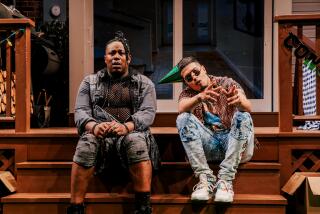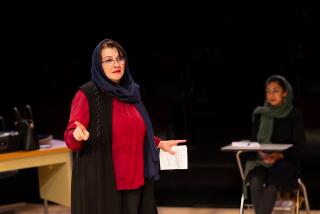‘Tribes’ uncovers a dysfunction both silent and spoken
In the play “Tribes,” a young deaf man with a boisterous, hearing family learns something from a new girlfriend that his parents and siblings never bothered to teach him: how to sign. He had always been expected to keep up with them by reading lips.
That man, a woman slowly going deaf and a family that willfully doesn’t learn sign language: Playwright Nina Raine explores the role of sound in the lives of these characters not just with the words, the director and the actors but the sound and projection directors. The chaos of both a deaf person’s world and the hearing world’s clumsy attempts at breaking through the silence are part of the audience’s experience in “Tribes,” which opens Sunday at the Mark Taper Forum.
“I was interested in the theatricality of being deaf,” Raine said by phone from London. “I was interested in deafness as a metaphor. You don’t have to literally be deaf to be deaf. None of the other family members really listen to each other either, and they aren’t deaf.”
TIMELINE: A history of captions and sign language on screen
The play opens in the family’s kitchen, with two aggressive, sometimes-funny, sometimes-vulgar shouting matches overlapping among the four hearing members. In the middle sits Billy, portrayed by Russell Harvard, eating quietly and unable to hear what’s going on; his eyes spring from parent to sibling and back, trying to discern what the fights are all about. Billy wears hearing aids, which allow him to hear sounds though not specific words, but needs to read lips to understand.
To add an extra layer to the story, the quarrelsome quartet (played by Will Brill, Lee Roy Rogers, Jeff Still and Gayle Rankin) are musical aesthetes. Music fills the room at times, each sound a different instrument that Billy can’t hear.
“The play is a lot about music, the way the family in which this man has grown up really appreciates music,” says Daniel Kluger, the show’s sound designer. “The play is built around these aesthetic pillars of opera, and people talk about music, and then we hear that music. We’re trying to make you feel in more detail the things you take for granted.”
Billy is at a party when he meets Sylvia (Susan Pourfar), who is losing her hearing because of a genetic condition. Throughout their courtship, they mouth to each other, and Sylvia shows him signs. During these silent moments, the dialogue is projected onto pieces of the set’s furniture for the audience to read.
“The challenge is where you put them,” says Jeff Sugg, the show’s projection designer. The projections are blasted onto different parts of the room — the ceiling, the plane above the piano — showing the effect of a deaf person’s sometimes frantic attempts to figure out where to look to understand what’s being said.
The audience must look away from the actors, able to “hear” what is going on only if they can see. (Similarly, director David Cromer says one challenge for the actors was making sure they were looking at Billy when they spoke, since they must have learned by then that he could read lips only when being faced directly.)
Eventually, Billy learns sign language and begins to wonder why his family never felt it was important to learn how he or they could communicate more effectively. In a visit home Billy refuses to speak, only signing, while Sylvia interprets. It’s a moment with a lot of silence and confusion as Billy’s family — and the audience — waits for him to sign, for her to interpret, for everyone to understand.
“At that point, we go to the position of this deaf boy,” says Raine of the long, tense silences during this scene. “It puts the audience and family in the same position because we can’t understand sign language. When we’re watching this boy gesticulating, we don’t know what he’s saying. There are no subtitles in the scene. In a way, we’re watching that and feeling deaf in the scene.”
Later, Billy is pushed to an emotional breaking point and pulls his hearing aids out of his ears. A rush of pink noise descends on the theater, drowning out the shouting.
“It’s a type of noise where we create the experience of obliterating all other content,” says Kluger. “We think of deafness as the absence of something, but this is a gesture of blocking out the pain of other people talking to you.”
Throughout the play, the interstitial darkness between scenes is punctuated by the screech of tinnitus, the roar of feedback from a hearing aid, an opera. The sound lends confusion in the name of Sylvia’s character. Near the end, as her hearing is going, she says, “No one told me it was going to be this noisy going deaf.... It’s this buzz … this roar and outside — it’s all — black.” The show that began with a full symphony slowly becomes silent.
“Along the way, those sound cues can mean anything you might feel,” says Cromer. “I hesitate to explain them because the only explaining we were willing to do about the sound cues was the act of playing them. We tried to find space for all the different sounds that Billy could not hear: everything from hugely cacophonous to a plate clattering off stage.”
The people working on “Tribes” were quick to point out that each deaf person’s experience of deafness is different. But there was an expert on hand to make sure the details were correct.
“The play is very accurate to my experience,” says Harvard, the deaf actor who plays Billy. “When they talk about the community, big D, little d deaf.” The reference is to politics of the larger deaf community and to individual deaf people.
Harvard removes his hearing aid to demonstrate the feedback. “The sounds are right,” he says.
---------------------------------------------------------
‘Tribes’
Where: Mark Taper Forum, downtown Los Angeles
When: Tuesdays through Sundays through April 14
Tickets: $40 to $70
Information: (213) 628-2772 or https://www.centertheatregroup.org
MORE
INTERACTIVE: Christopher Hawthorne’s On the Boulevards
Depictions of violence in theater and more
PHOTOS: Arts and culture in pictures
More to Read
The biggest entertainment stories
Get our big stories about Hollywood, film, television, music, arts, culture and more right in your inbox as soon as they publish.
You may occasionally receive promotional content from the Los Angeles Times.






